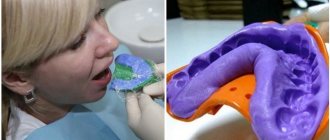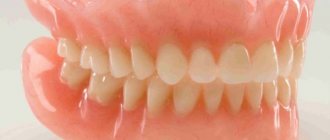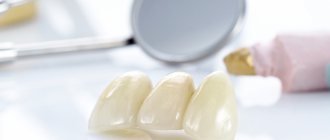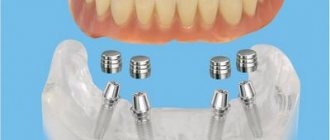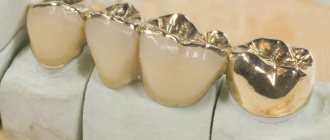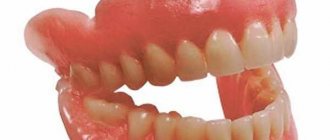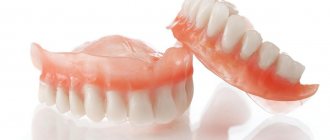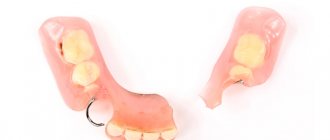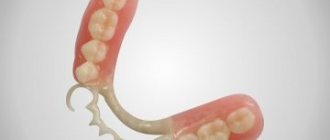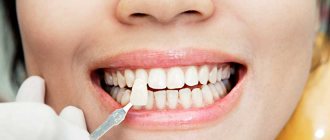2060
Considering that dentistry has in its arsenal a lot of new techniques and developments in the field of prevention and treatment of severe and advanced diseases, it is not always possible to maintain the health and functionality of dental elements into old age.
To restore lost units, dentists often resort to removable prosthetics. Clasp systems have proven themselves to be excellent, the production of which will be discussed in the article.
General overview
Clasp denture is one of the types of removable orthodontic structures. This is a very light, elegant, reliable and comfortable device to wear that does not distort diction.
All models of clasps are technically complex. They are based on a durable metal frame, a saddle-shaped acrylic base, artificial units and fastening devices.
All parts of the device are connected to each other by an arc. It also performs a fixing function. The frame itself can be made in two versions - solid cast or soldered. The second one is much easier to produce, cheaper, but not so convenient to use.
An important condition for the installation of these products is the presence in the mouth of several fairly stable and strong teeth. It is these units that will hold the removable structure.
The degree of sensitivity of the tissues and mucous membranes of the gums, the condition of the periodontium, and the size and shape of the alveoli are also of great importance.
Construction of the clasp prosthesis frame
The basis of clasp prosthetics is a frame made of heavy-duty material. As a rule, gold-platinum, chromium-cobalt and titanium alloys are used for its manufacture. Metal structures are the most common, but there are also metal-free prostheses, which are suitable for people with metal allergies, and plastic acetal prostheses.
The frame includes an arch connecting the right and left bases of the prosthesis. Bases are saddle-shaped parts of a prosthesis that imitate gums and hold artificial teeth, supporting and connecting devices. The frame is positioned in the mouth in such a way as not to cause discomfort for the patient. Special fasteners help with this, allowing you to hold the clasp denture in the oral cavity during chewing and speaking.
Purpose of structures
A clasp denture is one of many structures designed to reconstruct the integrity of the dentition in the absence of natural units on it.
Its installation is possible for the following indications:
- the presence of end bilateral and unilateral defects of the row;
- inability to place a non-removable device;
- loose teeth associated with periodontal diseases;
- the presence of single or included defects;
- replacement of anterior units;
- pathological abrasion of teeth.
The clasp is very often installed during preparation for prosthetics to preserve the overall aesthetics of the face. It can be used to correct deep bites, treat periodontal disease and bruxism.
Varieties
4 types of clasp devices have been developed. Each of them differs in its design features, manufacturing technology and material, and method of fastening.
With clasp fixation method
This is one of the most popular and inexpensive models. Clasps are small flattened hooks that tightly grasp the supporting units, securely hold the device in the oral cavity, preventing it from moving, and do not damage the enamel. They are part of a one-piece cast structure, and are made to match the parameters of the supporting teeth.
The indication for placing hooks on the clasp is the standard (or slightly larger) size and shape of the supporting elements.
They are also installed if the system is used as a medical splinting device (but then in this case several fastening links are placed on it).
The load when chewing food is distributed in such a way that the teeth remaining in the oral cavity experience minimal pressure, i.e. they account for only a third of it. The main part is distributed between the structure and the gums, which prevents the development of tissue atrophy.
A significant disadvantage of a product with clasps is its low aesthetics (the fastening cannot be positioned otherwise than on the front side of the teeth, so it is noticeable when communicating and smiling).
Fixed with micro-locks
Instead of clasps, miniature locks (aka attachments) can be built in. They consist of two parts, one of which (matrix) is built into the structure itself, and the second (matrix) is installed into a metal-ceramic crown that is placed on the support.
Fixation of the device occurs due to the automatic snapping of parts of the lock when putting on the prosthesis.
3 variants of micro-locks have been developed: rail, crossbar and spherical.
The model with attachments differs from the previous one in its higher aesthetic characteristics, since it is invisible to prying eyes. It is also more compact, lighter, and the fixation itself is more reliable. The load during meals is distributed evenly.
It is installed when the coronal part of the supporting element is sufficiently large and there are no pathologies of periodontal tissues.
A significant disadvantage of the device is the inevitability of grinding of the supporting units.
Fastenings with retractable (telescopic) crowns
These are two-piece caps that fit on top of each other. One is located on a support, the second is built into the structure.
The use of fastening is justified in the absence of a large number of teeth, the smoothness and small size of the remaining fragments, and chronic pathologies of periodontal tissue.
The load during chewing is placed only on the supporting elements, which minimizes the risk of damage to the mucous membrane and tissues. The system stands out for its high aesthetics, lightness and ease of use.
Despite all its positive characteristics, experts very rarely recommend its placement, since the product is difficult to manufacture and requires deep grinding of the supporting teeth.
Splinting (on beam) fastening
It is used for periodontitis, lack of most of the teeth, severe instability of the position of the remaining ones, but subject to the condition that the elements on which the structure is supposed to be attached are of sufficient height.
The device is two-part, that is, it consists of a non-removable part (beam) connecting the caps, and a removable part (matrix) mounted in the body. It is fixed on the inside of healthy teeth with metal plates that repeat the exact shape.
The duration of wearing the structure depends on the duration of treatment of the disease, but even long-term use does not damage the enamel or rub the mucous membrane.
Important! The doctor decides which type of clasp will be installed, based on the results of the patient’s examination.
Types of clasp dentures
There are four types of clasp dentures. Each has a lot of advantages, but also some disadvantages. The differences lie in the technique of creating products, methods of fastening, and the type of material chosen.
Clasp-fixed prostheses
The more popular and inexpensive ones are clasp-fixed prostheses.
Cast. They have a metal frame. The products securely and easily cover the supporting teeth and hold firmly without displacement.
The main stages of making a clasp denture with clasps: examination of the patient, taking an impression of the jaw, making crowns and arches of the clasp structure in the laboratory and fitting.
The design is able to correctly distribute the load when chewing food, with minimal impact on healthy teeth - they account for a third, and the rest is distributed to the gums.
Such a gentle effect on supporting teeth and gums helps prevent tissue atrophy.
Micro lock fastenings
Prostheses with micro-lock fastening differ from the previous type in the fastening itself.
Instead of clasps, they have small, unique locks.
The locks consist of two parts - one is fixed on the prosthesis itself, and the other is mounted on metal-ceramic crowns. These locks lock automatically.
Locks may differ: there are deadbolt, rail, and ball locks - their choice is determined by a specialist. The load during chewing in this case is uniform for both gums and teeth.
The stages of manufacturing a clasp prosthesis with locking fixation are similar to the stages of manufacturing a clasp prosthesis with clasps. According to the method of manufacturing locking fastening structures, there are: ready-made locking metal fastenings, elements of locking fastenings in the form of blanks made of special ash-free plastic or high-strength wax, combined fastenings.
Also, the stages of manufacturing a clasp prosthesis on attachments depend on the chosen technology - manufacturing a metal or plastic structure.
Dentures on crowns
Retractable clasp dentures on crowns have a unique design of two parts - upper and lower. The first part is removable and secured with a metal frame. The lower part cannot be removed because it is attached to the supporting teeth.
Removable clasp denture on telescopic crowns
The design allows you to evenly distribute the load on the patient’s gums and healthy teeth. The strength and reliability of the fastener is achieved through the interaction of the upper and lower parts. It is difficult to make such a prosthesis; only experienced specialists undertake the work.
Splinting prosthesis
With the development of many dental pathologies, the teeth are the first to suffer.
There is a need to strengthen them, pull them together and align them. In this case, it is recommended to use a splinting clasp prosthesis.
The product reliably fixes healthy teeth, secured inside with a metal plate that follows the shape of the teeth.
The service life depends on the time of treatment of the pathology. Even after wearing the product for a long time, you can see that the enamel and structure of the teeth do not deteriorate after wearing such a design.
Regardless of the type of clasp prosthesis, the principle of manufacturing such structures remains similar - a metal frame, fasteners and an acrylic base are created on which artificial teeth are attached.
Material used
All structural elements of the system are made using different materials. So, for the manufacture of the frame and arc, a cobalt-nickel alloy or stainless steel .
The alloy product is hypoallergenic and has a high biocompatibility with periodontal tissues.
Less popular is the system, the parts of which are made of steel. Its disadvantage is that an oxide film forms very quickly at the soldering points (its appearance indicates the beginning of the oxidation process).
The base on which the artificial chewing elements are placed is usually made of acrylic (a type of plastic). Despite the lightness of the material, it is quite durable.
All small elements (including fasteners) are made of titanium, which reduces the overall weight and parameters of the product. It is this fact that reduces the adaptation period to the system to 3-5 days.
For artificial chewing elements, metal-ceramics or ceramics (plastics are used less frequently).
Where does the process of making removable dentures begin, and what material is used?
Find out about the effectiveness of denture retaining spacers here.
At this address https://zubovv.ru/protezirovanie/semnyie-p/komu-podoydut-akri-fri.html you will find a selection of positive and negative reviews about Akri Fri removable dentures.
Materials for clasp prosthetics
The structural elements of clasp dentures can be made from different materials. Clasp dentures can have a metal or non-metal frame.
Materials for non-metallic parts of the structure are plastic, and metal ones are stainless steel and metal alloys (chrome - cobalt, gold - platinum, etc.).
The disadvantage of a structure made of stainless steel is that an oxide film forms at the soldering site, which indicates oxidation of the solder in the oral cavity. An oxide film forms at the junction of the clasp with plastic or clasps.
In modern denture practice, soldered clasp structures are used less and less. They were replaced by prostheses having a one-piece construction.
Clasp dentures with a monolithic frame are considered the best today.
Technologies
The design of the clasps is complex, so they are made only in dental laboratories equipped with special equipment. Two technologies are used for this:
- Casting with removal of the model from the blank. The method involves taking a wax impression from a plaster model and then placing it in a refractory compound. The wax is removed and replaced with liquid metal.
- Casting a refractory sample, during which the base is modeled.
This method has two advantages over previous technology. Firstly, the metal does not “shrink”, and secondly, the possibility of changing the parameters of the wax blank during its removal from the model and packaging into a refractory mass is excluded.
Important! Cast structures are very thin, reliable, lightweight and very accurate, so the period of getting used to them is very short.
Production
The production of clasps is a labor-intensive, lengthy process that takes place in several stages. All of them are created individually for each patient using casts of his jaws using special equipment in specialized workshops.
Clinical stage
Includes several visits to the dentist, during which:
- Initial examination of the patient. The doctor analyzes the general condition of the oral cavity and dentition, determines the type of occlusion, selects supporting units and determines their quality.
Also draws up a plan to eliminate the defect. If any pathologies, injuries, or ulcers are found in the mouth, then the installation is postponed until complete recovery. - Preparation of supporting units for prosthetics. If necessary, the dentist treats them and grinds them down.
- Taking impressions of both jaws to create two models: diagnostic and auxiliary.
The process then continues in laboratory conditions. Afterwards, the patient is invited for a trial fitting of the design. If there is a need to correct it, eliminate identified flaws and inaccuracies, the product is again sent to the laboratory for finishing and adjustment. - Final placement of the system in the mouth , checking balance.
After fixing the system, the specialist advises the patient on care and operation.
Laboratory stages
After receiving the impressions, the production of the clasp continues in the laboratory. This process is also multi-step:
- Creation of a diagnostic version of a model made of marble plaster, which takes into account all the features and details of the anatomical structure of the patient’s mouth.
- Modeling the type of bite by precisely positioning the jaws relative to each other.
- Measurement of pressure on those units that are supposed to be used as reference for the system.
- Drawing a diagram of the future design on the layout , its graphic representation.
- Simulation on the same model of the process of grinding teeth-supports.
- Creating a model of the system frame, casting the frame.
- Installation of artificial chewing elements on wax balls, and the formation of a restored fragment of a row from them.
- This structure is placed in a plaster mold , melted, the wax is removed, and an acrylic mass is poured in its place.
- Connecting all parts into one structure, grinding and polishing.
Next, the finished product is sent to an orthopedic doctor to secure it in the patient’s mouth.
The video presents an option for making a clasp prosthesis with clasp fixation.
The main stages of manufacturing a clasp structure
- Clinical stage of prosthetic manufacturing.
- Manufacturing the structure in the laboratory.
- Clinical stages of prosthetics:
- Patient examination. Before making clasp dentures, a treatment plan for the patient is developed in detail, the supporting teeth are determined and their preliminary preparation is carried out.
- Taking impressions of both jaws of the patient. Impressions are taken with an individual spoon. In order to make a clasp structure, it is recommended to take two impressions from each jaw.
- After making the prostheses in the laboratory, they are tried on and, if necessary, corrected.
- Final fixation of the structure in the oral cavity.
Laboratory stages of manufacturing clasp dentures
Photo: Laboratory production of a prosthesis
- Casting models from ready-made impressions in highly durable gypsum (marble gypsum) so that they do not break when manipulated.
- Drawing the frame of the clasp structure.
- Manufacturing and modeling of a clasp prosthesis frame.
- Casting of the structural frame. Grinding, polishing the frame.
- Fitting the frame of the clasp prosthesis on the model.
- Wax base modeling, selection and installation of artificial teeth.
- Trying on the structure frame in the patient’s oral cavity.
- Replacement of wax with plastic, final processing of the prosthesis (polishing, grinding).
- Fitting with overlay of clasp design.
Creation time
The creation of clasp systems takes more time than the production of other removable structures:
- the device with clasps takes about 10-12 days;
- analog product with attachments – at least 20 days;
- the system on telescopic crowns will be ready in 3-4 weeks.
But these are only approximate times for the technician to complete the work. Depending on how busy it is, production may take longer, or vice versa, it may be halved.
Useful recommendations on where to place a covering prosthesis, and what to look for when choosing a specialist.
This material is devoted to the design of the Sandwich denture.
Here https://zubovv.ru/protezirovanie/semnyie-p/byugelnyie/na-nizhnyuyu-chelyust.html about the features of making a clasp denture for the lower jaw.
Production stages
Making a clasp device is quite difficult. Labor-intensive work is divided into two stages: clinical and laboratory.
Clinical stage
Any type of prosthetics requires a mandatory visit to the dentist and preparatory measures.
To complete the clinical stage, 6 visits to a specialist will be required:
- diagnostic procedures, drawing up a treatment plan;
- preparation of reference specimens (treatment, preparation if necessary);
- taking impressions from the jaws (2 copies from each jaw);
- making a model of the future product;
- fitting session, correction;
- final installation of the product in the oral cavity.
Laboratory stage
After the impressions are delivered to the laboratory, the stage of manufacturing the clasp device begins. It includes the following manipulations:
- Making a diagnostic model from marble plaster. This will make it possible to create an accurate individual device for a specific clinical case, taking into account the smallest details of the structure of the oral cavity.
- Accurate characterization of occlusion in different planes.
- The stability of the supporting units under the influence of loads received from the manufactured device is determined.
- Drawing a picture (drawing, graphics) of the future product on a plaster model.
- Simulation of the preparation process of supporting units using a plaster copy.
- Formation of a wax copy of the base and future frame according to the finished drawing.
- The casting process of making a frame from a created wax copy.
- Installation of artificial specimens on wax rollers, their formation on a plaster copy.
- Placing the wax apparatus with units in a special plaster mold. Melting of wax and its subsequent removal. Pouring acrylic plastic. Connecting all parts of the structure to each other.
- Handing over the finished product to an orthopedist.
The video shows the stages of making a clasp prosthesis.
Contraindications
In addition to prescriptions for the use of clasp dentures, dentists identify conditions in which their installation is impossible. These restrictions can be divided into 2 groups: absolute and temporary (conditional).
Absolute restrictions include the following conditions:
- insufficient height of supporting teeth or their absence;
- pathological changes in structure in the periapecal tissues of these units;
- atrophy of the alveolar processes;
- severe malocclusion of the lower jaw;
- low, or, on the contrary, high fixation of the frenulum of the tongue;
- mental disorders;
- diabetes;
- pathologies that weaken the immune system;
- malignant formation in the oral cavity.
Important! Identification of one of these conditions is the basis for refusal to perform prosthetics and a reason for selecting another method of correcting the dentition defect.
The group of relative contraindications includes:
- pregnancy at any stage and the period of breastfeeding;
- exacerbation of existing chronic diseases;
- recovery period after surgery;
- insufficient number of supporting teeth;
- drug or alcohol addiction;
- heart failure in the active phase;
- insufficient oral hygiene;
- viral or infectious diseases.
Important! Considering that a significant part of the limitations can be eliminated, prosthetics with clasp devices is a real way to reconstruct the dentition.
Stages of clasp prosthetics
The patient needs to be prepared for several visits to his doctor. The clinical stages of prosthetics are very important, since it is thanks to them that the doctor receives all the necessary parameters for the laboratory production of the prosthesis. At the same time, no templates or ready-made forms are used for this prosthesis; all mechanical and technical parts of manufacturing are carried out individually in the laboratory.
- The first step towards the production of high-quality clasp dentures is the creation of a diagnostic dentofacial model. It is a plaster cast that reflects the relief of the jaw and dentition, as well as soft tissues. This model allows you to evaluate the vertical distance between one row of teeth and another, the shape, size of the selected supporting teeth and the characteristics of the defect in a particular patient. At the same stage, the specialist determines the type of bite and studies the load on the supporting teeth.
- Then the doctor selects a suitable attachment - a special device on which the prosthesis will be attached. To do this, the specialist will need to study the clinical situation and the results of the x-ray.
- Using the diagnostic model, the future prosthesis is designed and a special drawing is created.
- The supporting teeth are prepared to create enough space for the subsequent installation of the structure.
- The choice of a locking or telescopic method of attaching a prosthesis involves installing crowns on the supporting teeth. Crowns will also be needed if the supporting tooth is tilted or has undergone restoration. The installation of crowns begins with the manufacture and fitting of their frame. The crowns must fit perfectly into the clasps of the denture. At this stage, it is important to take into account the color of all ceramic elements, as this will affect the aesthetic appearance of the structure.
- Based on the impression of the jaw, the specialist makes a plaster prototype of the prosthesis.
- Only now can we begin to create a working prosthesis. To do this, a new impression is made taking into account the fixed crowns. The resulting cast is duplicated to create a fireproof model. Then the frame of the prosthesis is cast from titanium, gold-platinum or chromium-cobalt alloys. After polishing the finished frame, the unloading and support-retaining elements of the prosthesis are fastened.
- The finished prosthesis is tried on in the oral cavity. The accuracy of fastening installation is assessed. If necessary, the fit of the attachment is adjusted.
- After successful testing of the prosthesis, artificial teeth of the selected color are attached to the base of the structure.
- Finally, the structure is installed in the mouth using anchors and cementation.
Advantages and disadvantages
Clasp prosthetics have the following significant advantages over other removable orthodontic structures:
- Compact and lightweight.
- Good fixation in the mouth.
- Correct pressure distribution during eating.
- When the system is attached to the upper jaw, it does not cover the entire palate, which means it does not lead to a change in the taste perception of food or impaired diction.
- Easy to care for.
- Duration of operation.
- Possibility of installation for the treatment of periodontal diseases.
- Various fixation methods.
- Short adaptation period.
The invention of structures pushed into the background all other removable systems. Today, clasps are considered the best options for replacing lost teeth.
But even despite the large number of advantages, this device has a number of disadvantages:
- For placement it is necessary to perform turning.
- The process of atrophy of jaw tissue develops.
- Some types of fastening (clasps) are not aesthetically pleasing.
- High cost compared to other designs.
But even these shortcomings do not affect the demand and popularity of clasps among patients.
The structure of clasp dentures
The design of the prosthesis includes three main components:
- Frame. Made from an alloy of cobalt and chromium.
- The basis. Made from acrylic, polymer teeth are mounted on it.
- Retainers. A specially designed system is used to secure the product in the mouth.
A solid-cast or soldered metal frame connects the parts of the product into a single whole, and also serves as a base and fixation. Cast frames, despite their higher cost, are gradually replacing soldered frames. The arc is made from stainless steel or an alloy of chromium and cobalt. Fixation of the prosthesis and its use is possible if there are several natural healthy teeth.
The main advantage of a clasp prosthesis is its smaller thickness compared to a standard product. This also affects the volume of the product. Wearing comfort is ensured by a cast metal frame.
Clasp dentures with a solid frame are considered the best today.
Rules of care
The service life of the system, subject to strict adherence to all rules of care, is approximately 10 years. Also, their implementation will help prevent inflammation of the mucous and periodontal tissues:
- It is good to rinse your mouth with water or mouthwash after each meal.
- Clean the structure twice a day, being sure to remove it before the procedure.
- Treat in the same way as natural teeth, using paste and a classic brush. Highly abrasive pastes should not be used for the procedure.
- Each time after removal, treat with an antiseptic (it is better to do this before going to bed).
- Rinse only with warm water. Do not use alkalis or highly acidic products.
- Eliminate hard and sticky foods from your diet, and avoid hot foods and drinks.
- Protect from accidental falls and breakages.
It is also necessary to perform position adjustments and professional dental cleanings at least once a year.
.
The above rules of care are simple and easy to follow. Compliance with them will ensure the preservation of the functionality of the system and comfort during operation.
Cost of clasp dentures
Prices for clasp prosthetics are determined by several factors. First of all, the costs depend on the complexity of the prosthetics, the type of material and the design of the product. For example, fixation with locks will cost more, since it takes into account the cost of locks and additional crowns. In addition, the cost also includes preparing natural teeth for prosthetics.
- A standard prosthesis will cost $250.
- If you install a splinting product, its price starts from $300.
- If you choose a design with locks, its price will vary from $600 to $800.
Despite the relatively high prices, the demand for clasp prosthetics is constantly increasing. The popularity of products is influenced by their strength, durability and ease of use. First of all, the patient is interested in comfort when using the prosthesis, which is fully realized in the clasp design.
| Cavities are no longer a problem! Do you have caries, but are you afraid to go to the dentist? You can cure it at home! Read more >>> |
| How I whitened my teeth in a short time After 1 week, my teeth became SNOW-WHITE! I just did... Find out more >>> |
| The best remedy for getting rid of headaches Vladimir Pozner: “Because of terrible headaches, my career on TV hung by a thread” Read more >>> |
Your mark:
(votes: 1 , average: 10.00 out of 10)
Price
The cost of clasp structures is high in comparison with other removable products. But, despite this fact, their use today is one of the most popular services in dental clinics.
This table provides information on the average cost of various clasp systems. These figures already include payment for oral cavity preparation services.
| Type of prosthesis | Price, thousand rubles |
| Simple for one jaw | from 15 |
| System for 2 jaws | about 25 |
| Splint system | from 20 |
| Micro-lock design | about 40 |
| Product on telescopes | about 70 |
The figures given are subject to change. Their upward fluctuation depends on the complexity of the design itself, the type of material used in production, and the type of fastening used.
The cost of prosthetics with clasp structures
Clasp prosthetics is one of the popular methods of removable dental prosthetics today.
The cost of the prosthesis depends on the complexity of its manufacture and on the materials used in the manufacture of the structure. The price of the dental structure will also depend on the type of attachment of the prosthesis to the teeth. Designs with locks are expensive, because they include the cost of locks, as well as crowns.
The cost of prosthetics may include services for preparing teeth for prosthetics: dental treatment, installing crowns on abutment teeth and taking impressions.
| Type of clasp prosthesis | Price in rubles |
| Simple clasp prosthesis | 15000 |
| Complex clasp prosthesis | 20000 |
| Splinting clasp prosthesis | 20000 |
| Simple clasp design with locks | 50000 |
| One-sided clasp prosthesis with locks | 35000 |
Reviews
Clasp dentures are considered a worthy replacement for lost dental units. They received a lot of positive ratings from experts and people who tested their characteristics from their own experience.
They note reliability, quality, comfort, convenience and long-term operation without repair.
You can talk about your experience and share your impressions of dentition reconstruction with clasps by leaving a comment on this article.
If you find an error, please select a piece of text and press Ctrl+Enter.
Tags clasp denture removable dentures
Did you like the article? stay tuned
